Beyond Acadia | A Summer Exploration of Coastal Northern Maine
Venturing beyond Acadia reveals a world unlike any other in New England.

Two hours northeast of Acadia National Park, outdoors lovers can find a quieter but no less stunning destination for kayaking, hiking, biking, and camping at Cobscook Shores, a collection of 20 privately owned parklands clustered on the southern and western shores of Cobscook Bay.
Photo Credit : Cait BourgaultBy Wayne Curtis
Far Down East Maine is surprisingly hard to reach for an area that contains much of Maine, a state that contains nearly half of New England.
Some of that difficulty is geographic—it’s a pretty far piece from most metro areas. But part of the challenge is also psychological. Because when you drive as far northeast as Ellsworth—about five hours from Boston if poking along coastal Route 1—you’ll be drawn as if by a magnetic force southward to Acadia National Park. That’s not unexpected. It’s one of the most visited national parks in the country, highly Instagrammable, and spectacular. You should go sometime.
But it’s also crowded. There’s almost always a conga line of summer traffic that snakes through Ellsworth and down Route 3 toward Bar Harbor. Focused on the car bumpers in front of them, travelers may not even notice the sign pointing left toward “Scenic Downeast,” even though the sign has a stylized logo depicting the sea, a pine-clad point, and a rising sun. In a state as famously understated as Maine, this sign is the equivalent of an inflatable arm-flailing tube man at a car dealership.
Few make the turn. Yet when you do so, you’ll find the crowds fall off and the terrain opens up. An hour east of Ellsworth is the historic village of Columbia Falls. A prominent family here—successful makers and sellers of holiday wreaths—have come up with an audacious scheme to lure travelers beyond the Acadia turnoff. They’ve proposed building the world’s tallest flagpole—called the “Flagpole of Freedom”—amid the rolling evergreen woods where they source their fir tips.
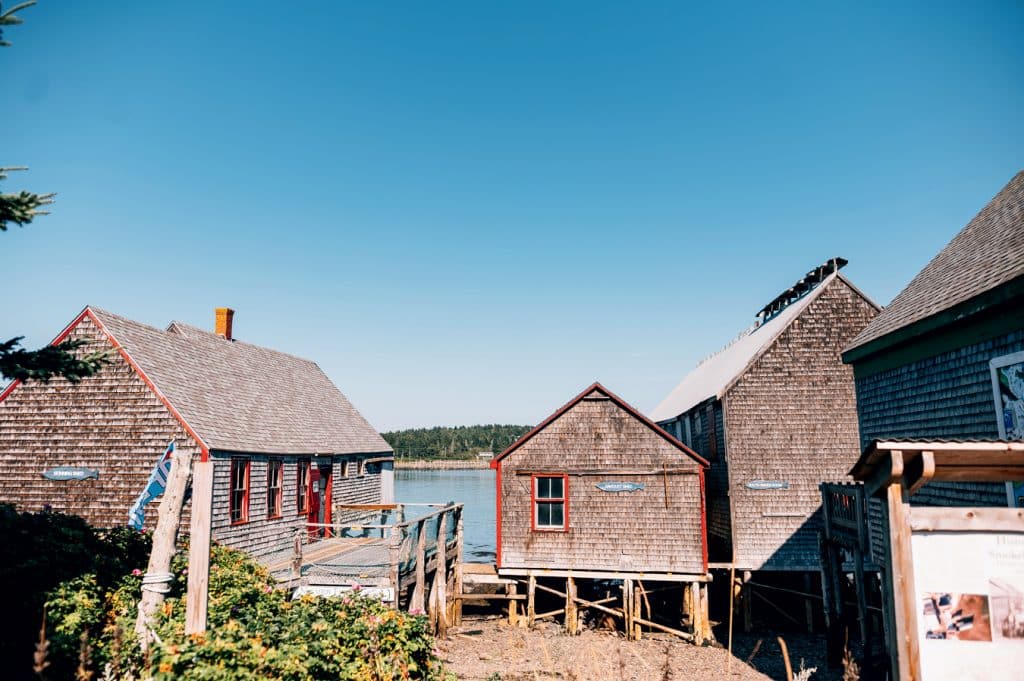
Photo Credit : Cait Bourgault
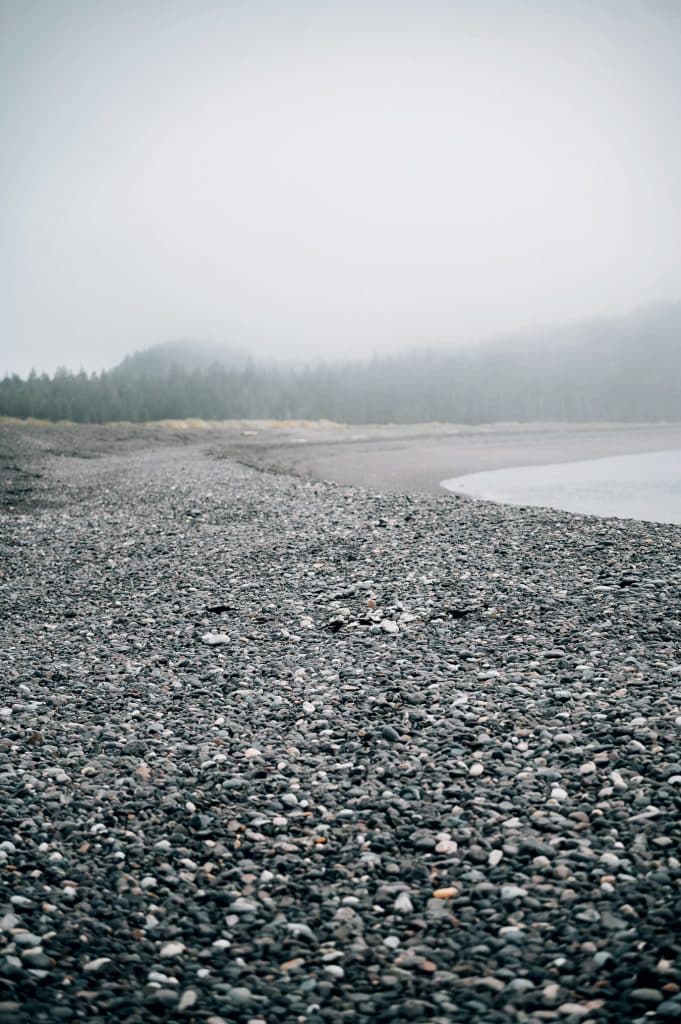
Photo Credit : Cait Bourgault

Photo Credit : Cait Bourgault
As envisioned, the flagpole will rise nearly 1,500 feet, or taller than the Empire State Building. Atop it will flutter “the largest American flag flown in the world,” about the size of a football field and a half, and large enough to be tauntingly visible from Acadia’s mountaintops. At the apex of the pole, like a finial, will be a multistory World’s Fair–like glass sphere/observatory, which visitors will reach by one of three elevators. From here they can enjoy views 100 miles in every direction, from Mount Katahdin to Nova Scotia.
The proposed project actually involves more than a flagpole. Around its base would be a 2,500-acre Flagpole of Freedom Park. Here, visitors would be able to take scenic drives through dense forests, ride six miles of gondolas across the rolling hills of balsam fir and spruce, stay at a hotel, visit a theater, dine in restaurants, and explore a series of exhibits honoring our nation’s veterans. Also, there would be a full-scale re-creation of a historic village where “every day will feel like the Fourth of July.” The project’s founders estimate that the park will cost $1 billion to build, require 5,000 employees to run, and attract 6 million visitors each year, or about twice as many as venture to Acadia. The concept is essentially to create Branson, Maine, from almost nothing.
It’s unclear whether this ambitious project will ever be built. The project has already raised flags, mostly red. Construction had already started on log cabins for travelers (“Flagpole View Cabins”), but state officials cited it for environmental violations soon after it opened. Some vexing questions of local oversight and jurisdiction have yet to be ironed out. And local residents have wondered aloud where those 5,000 employees would reside in their village, which has a population of 500.
None of this lofty activity is actually much of a surprise. Maine’s easternmost region has a long history of folks proposing transformative, large-scale projects that fail to see the light of day—from the Roosevelt-era plan to dam Cobscook Bay’s inlets and harvest the tides for electricity (1930s), to a massive oil refinery in Eastport (1973), to a liquid natural gas facility with a three-quarter-mile pier south of Calais (2014).

Photo Credit : Cait Bourgault
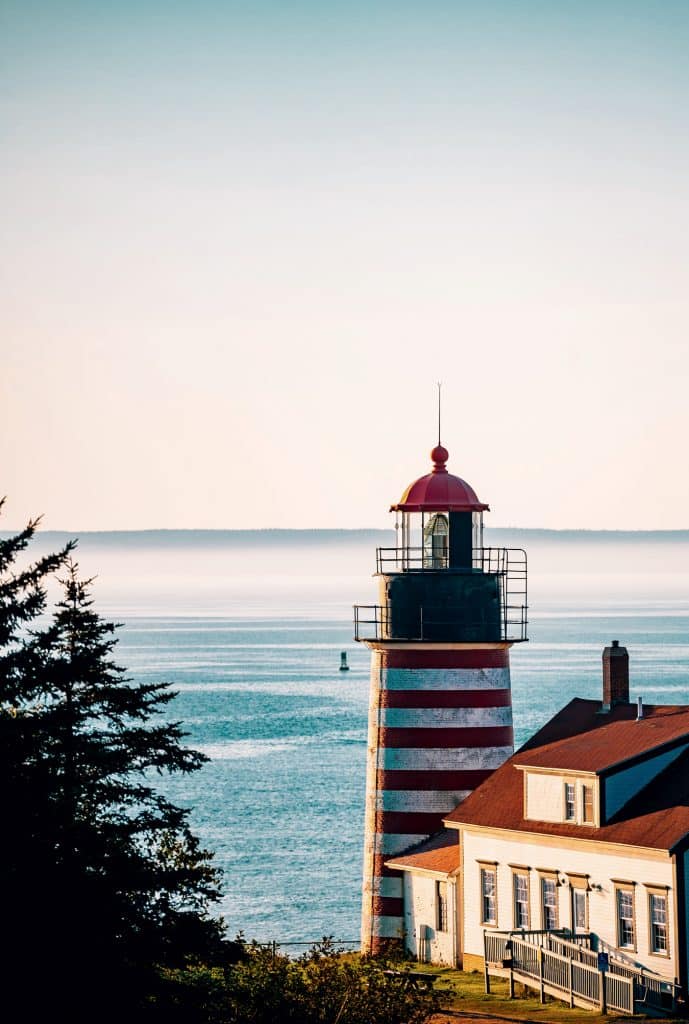
Photo Credit : Cait Bourgault

Photo Credit : Cait Bourgault
Washington County—which makes up much of far Down East Maine—has long been regarded as a problem that needs to be solved. It needs more economic development, it’s said; it needs more people, it needs to become unstuck from its ways. The towns are small, with fewer than half a dozen boasting more than 1,000 residents. There are no major resorts for travelers, nor even much in the way of motels. Dining out tends to involve picnic tables. It’s been stuck in the 1950s, and seemingly unable to find its way out.
“I mean, everyone is looking for the single magic bullet,” says Hugh French, who grew up in Eastport, where he is now director of the Tides Institute & Museum of Art. “Perhaps in an ideal world that might be possible, but I think that’s more often not the case. And I think a lot of smaller, more diverse projects can be more successful. They can also be more suited to an area like this.”
Indeed, if there’s been any trend over the past couple of decades, it’s been the abundance of smaller, low-profile projects, many involving land conservation. While large-scale land acquisitions may command attention elsewhere in the state—such as the 87,500-acre Katahdin Woods and Waters National Monument, created in 2016—local nonprofits, the state, and even individuals have been acquiring and preserving tens of thousands of acres of land hereabouts, opening much of it for public use.
Washington County, it turns out, isn’t so much a monolith as a mosaic—a vast array of small attractions. It’s more about landscapes than landmarks, and part of the allure of exploring here is making these small discoveries. It’s an excellent place to develop your knack for finding where you need to be, even if you didn’t realize it.
”I’ve always had people who were adventurous,” says Bonnie Dunn, who’s owned and operated Micmac Farm Guest Cottages in Machias for the past four decades. “They like the outdoors. And most people are grateful—they’re looking for a place to get away from the crowds.”
Which is all a way of saying that the region may be gradually finding its way out of the 1950s, but doing so at its own pace, and at its own scale.
To explore this part of Maine youwill certainly need a car. Yet it is equally certain that if you remain in your car, you will miss the entire region. It’s good to remember the great travel writer Eric Newby’s observation from the 1950s: “If there is any way of seeing less of a country than from a motor-car I have yet to experience it.”
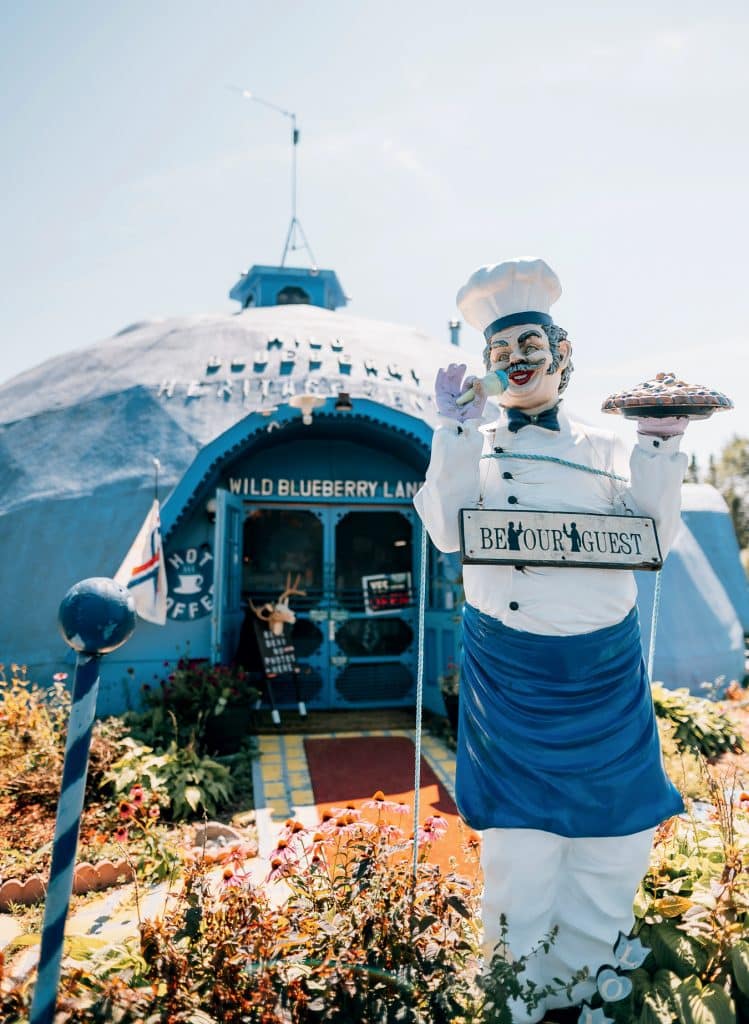
Photo Credit : Cait Bourgault
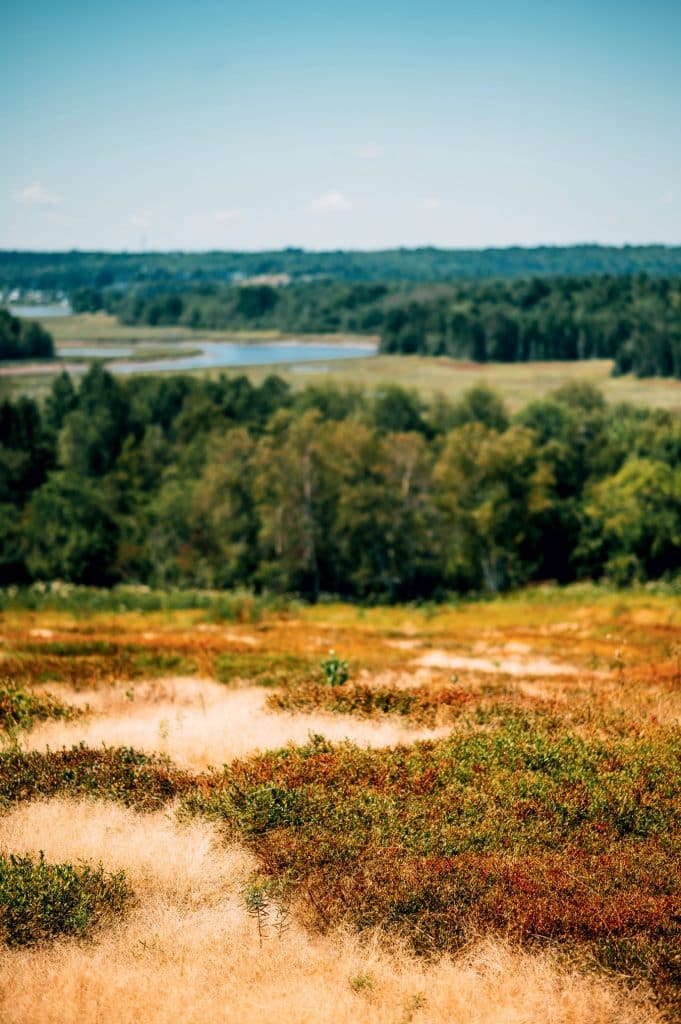
Photo Credit : Cait Bourgault
Jasper Beach is a 20-minute drive south of Machias, the county seat, reached via a narrow road with sandy shoulders that snakes along Machias Bay and past open fields and small settlements. Like many beaches, Jasper Beach has dunes, except these dunes are composed of rocks, all round, some quite large and deeply hued. Walking down the beach, I was occasionally distracted by the remarkable views toward the Gulf of Maine, but generally my thoughts were of the complicated biomechanics of ankles, which needed to act like gimbals to keep me upright as the rounded rocks slid and resettled beneath me.
At the far end of the half-mile beach, hard up against flinty bluffs, water flows in a crystal stream past seaweed-covered rocks from a tidal pond ringed with marshes impounded behind the stone dunes. The remarkable sights command attention, but the sounds are the most memorable. The sea surges in and then pulls away, leaving the beach to mumble and mutter as the rocks agitate against one another, becoming ever more round.
At many rocky coastal areas, visitors give in to some primeval urge to stack rocks atop one another into tottering towers. Not here. Enterprising visitors have collected black rocks and white rocks and made surprisingly detailed mosaics of them—hearts, mermaids, and one grand lobster 10 feet by 12 set on a white tabletop—all awaiting erasure by high winter waves.
Small discoveries such as this abound along the coast. As such, a journey here can feel more like a scavenger hunt than a tour.
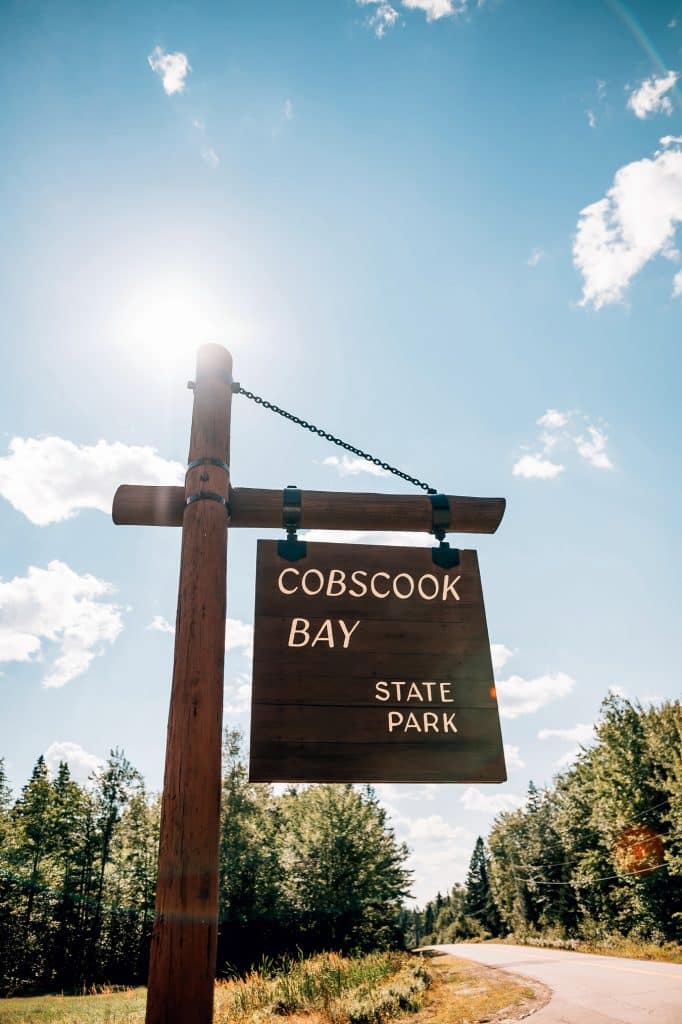
Photo Credit : Cait Bourgault

Photo Credit : Cait Bourgault
Among the nonprofit groups thathave collectively acquired and preserved thousands of acres of land hereabouts are the Nature Conservancy, the Downeast Salmon Federation, Downeast Coastal Conservancy, and, further inland, the Downeast Lakes Land Trust. And there are national wildlife refuges, including Moosehorn and the Maine Coast Islands National Wildlife Refuge Complex, along with state-owned lands. Among the state’s jewels here are Cobscook Bay State Park, with its surfeit of waterfront campsites overlooking the bay’s 20-foot tides, and the Cutler Coast Public Reserved Land, which draws serious hikers who trek along a 10-mile loop that runs atop craggy coastal cliffs and then plunges down to expansive ledges and hidden pebbly beaches.
The Maine Coast Heritage Trust was founded in 1970 in response to increasing shoreline development, and today it owns some 180,000 acres statewide. Twenty of its preserves are located Down East, and these often take some sleuthing to find. Among the more alluring is the Boot Head Preserve, located between Cutler and Lubec. It’s epic Maine coast, distilled to accessible size. Trails on this aptly named “Bold Coast” pass through loamy, mossy forests that drip as steadily as a metronome when the fog blows in, and then twist down to broad cobblestone beaches and across high, open bluffs. A small wooden platform with a bench overlooks one cleft in the cliffs, inviting hikers to sit and think about every book they’ve ever read involving pirates and the places they hid.
Among the newest conserved lands is a constellation of 20 privately owned and publicly accessible parklands near Lubec called Cobscook Shores. This project was launched in 2021 by Butler Conservation Inc., a foundation created by equity pioneer and avid sea kayaker Gilbert Butler. Aiming to preserve lands in the far Down East region (the family foundation also has projects in northern Maine, South Carolina, and elsewhere), the group has cobbled together a patchwork of waterfront lands totaling 500 acres and 12 miles of shorefront.
These are “fun-size wildlands,” offering easy access to woodlands and waterfront so quiet you can hear the slurping of the tides coursing in and out. At Denbow Point I walked along a mossy pathway through dense pines to a tidal cove and rocky point. Not far away, a 10-minute hike at Pike Lands took me across a log-slab walkway to nearly a mile of shore, with a lagoon, marshland, and a 1,700-foot gravel beach—a world near yet apart from the ancient apple orchard where the walk begins.
“I love the landscape of Washington County,” says Susan Hand Shetterly, a longtime Maine author who often writes about the region. “I love its roughness and its beauty. And the light is different—it changes the further east you go.”
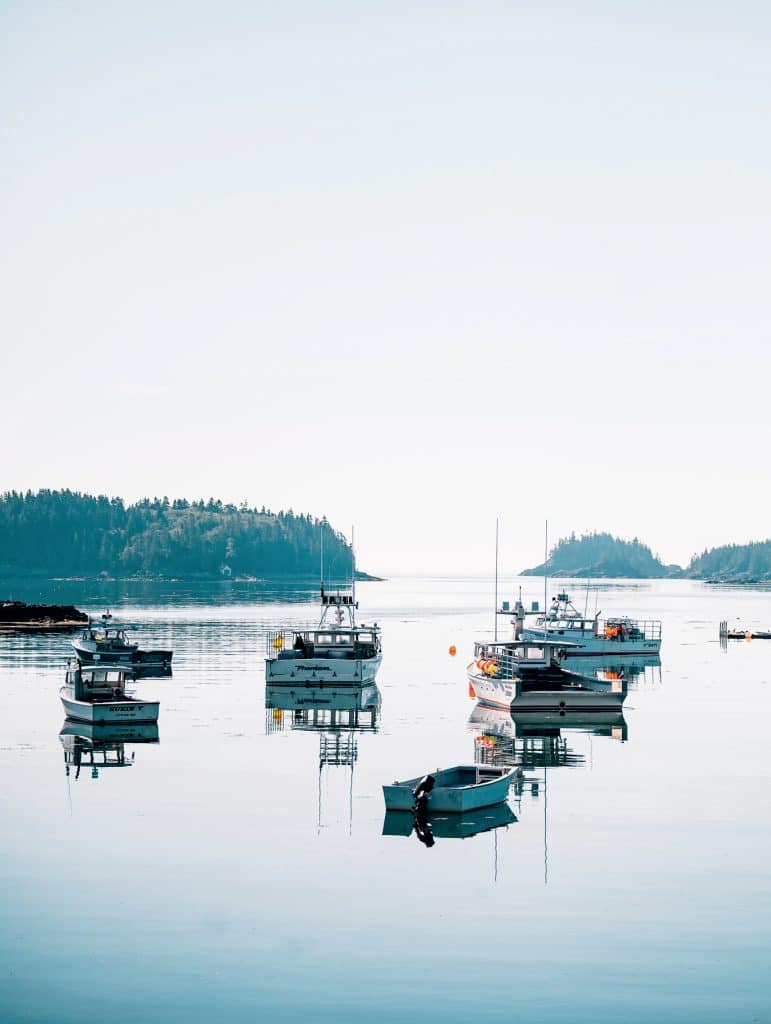
Photo Credit : Cait Bourgault

Photo Credit : Cait Bourgault
For reasons unknown, the light seems especially lambent across the blueberry barrens. You’ll find these throughout the region, where they open up in the coastal forest like hidden rooms. Further inland, they cover vast swaths of the uplands, especially near Columbia Falls and Cherryfield. Washington County is the heart of Maine’s blueberry empire—in the 19th century, canneries were commonplace, bringing Maine’s small, delicate berries to the world. Larger, plumper berries from New Jersey and beyond displaced Maine’s supremacy in the 20th century. But few in Maine are seduced by size; many boast of the smallness of their blueberry, and note with some pride that compactness comes with an outsize, distinctly fresh taste. Once again, small prevails.
Well, except at Wild Blueberry Land, an incongruously eye-catching geodesic dome right off Route 1. It’s painted to look like a giant blueberry come crashing to earth, and inside visitors find all things blueberries. It’s been a restaurant and gift shop since it opened in 2001, but owners Dell and Marie Emerson, who are also committed blueberry growers, converted it to a heritage center this year. Their goal is to tell the story of the Maine blueberry, and how the soil and climate and plants have converged to provide an unrivaled natural treat.
When exploring these coastal lands, I sometimes feel as if I’m trespassing on the sea, coming through the backyard and arriving unannounced at the back door. Route 1 offers connection and convenience, for sure, but the sea is how the region was first settled by Europeans, and the names on the charts suggest not what you see when walking on trails and across the headlands, but when approaching by boat: Fairy Head, Pot Head, Eastern Knubble, Sea Wall Point, Crumple Island. At other coastal areas, you often find prominences named after the first people or the early settlers; here, it’s as if the land hasn’t yet wrested free from its post-glacier geography.
Getting on the water can be a daunting proposition—not a lot of services exist—but a little effort pays dividends. Butch Harris runs tours on a fishing boat out of Eastport, where you can witness the fearsome tides of Passamaquoddy and Cobscook bays up close. Sunrise Canoe and Kayak in Machias offers day trips by kayak on Machias Bay, or you can rent a kayak by the day or week. Bold Coast Charter Tours runs passengers to Machias Seal Island with its colorful colony of puffins. Capacity is extremely limited (and tours sell out early), but when the seas allow passengers to disembark on the island, they spend a memorable time at one of four blinds that offer photographers and birders close-ups of puffins—which, let’s be honest, are basically penguins with poor makeup skills.
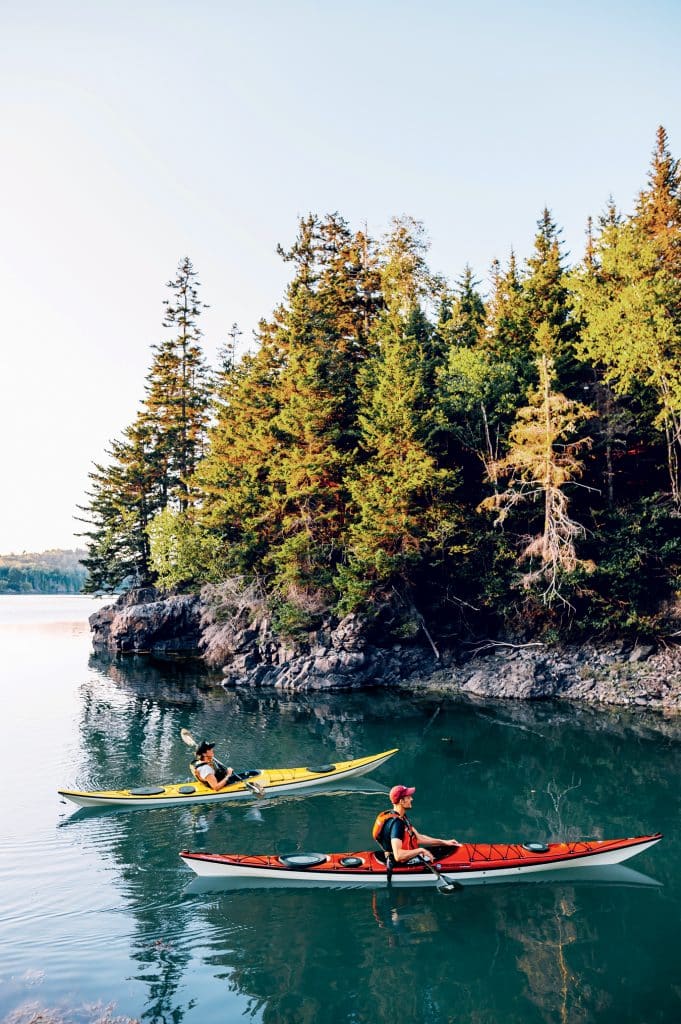
Photo Credit : Cait Bourgault

Photo Credit : Cait Bourgault
I had read of ancient petroglyphs left by generations of Passamaquoddy on islands and headlands in Machias Bay and written up in academic journals. I went out on two separate days in my own kayak. One day in late summer it was windy with the tang of autumn in the air and the gray seas were steep. I didn’t linger long.
Another day, calmer and warmer, I skirted islands and headlands and poked around rock ledges for hours, but still failed to find petroglyphs. Or rather, I found only petroglyphs—every glacial scraping and rock fissure and Rorschach of seagull guano seemed to carry a message, all of which said, You are a fool to even venture here looking for petroglyphs. A patio-size, flat-topped boulder provided the perfect place to stop and enjoy lunch, as well as horizon-to-horizon views of sky and evergreen and stone.
As is often the case in this part of Maine, when you look for one thing, you find something you didn’t expect that’s even grander.
A bit to the east, Cutler Harbor is improbably picturesque, deeply set amid gentle hills scattered with homes more than a century old, and dotted with lobster boats. Not much is going on here—no motels, no restaurants, just a lobster pound that offers lobsters to cook at campsite or cabin—but that’s part of the appeal. From the boat launch it’s a 10-minute paddle out to Little River Island, a 15-acre gem with a lighthouse built in 1876 that stands sentry over the mouth of the harbor. The island is owned by the American Lighthouse Foundation, which welcomes respectful visitors. A half-mile wooden boardwalk runs through forest dense enough to cast perpetual twilight, and ends at layered ledges with endless views up an unpopulated coast. The keeper’s cottage is open in summers for overnight accommodations, and provides fertile ground for idle reveries about cutting one’s ties, living on an island accompanied only by seals and the mournful bleat of a foghorn.
Eastport is the easternmost city in America, although the “city” designation can seem more aspirational than actual. It has a population of around 1,300, which is down from its peak of 5,300 in the 19th century. Then, it was indisputably a city and filled with the constant hum of activity and fishermen and merchants arriving and departing from all around Passamaquoddy Bay, which the U.S. shares with Canada. “From the wharf you get the impression that the sole occupation of Eastporters is either fishing for or canning sardines,” noted a 1906 visitor. Another in 1918 reported that “at times there have been so many Canadian craft tied up in some docks that a person would walk from dock to dock by stepping across these boats.”
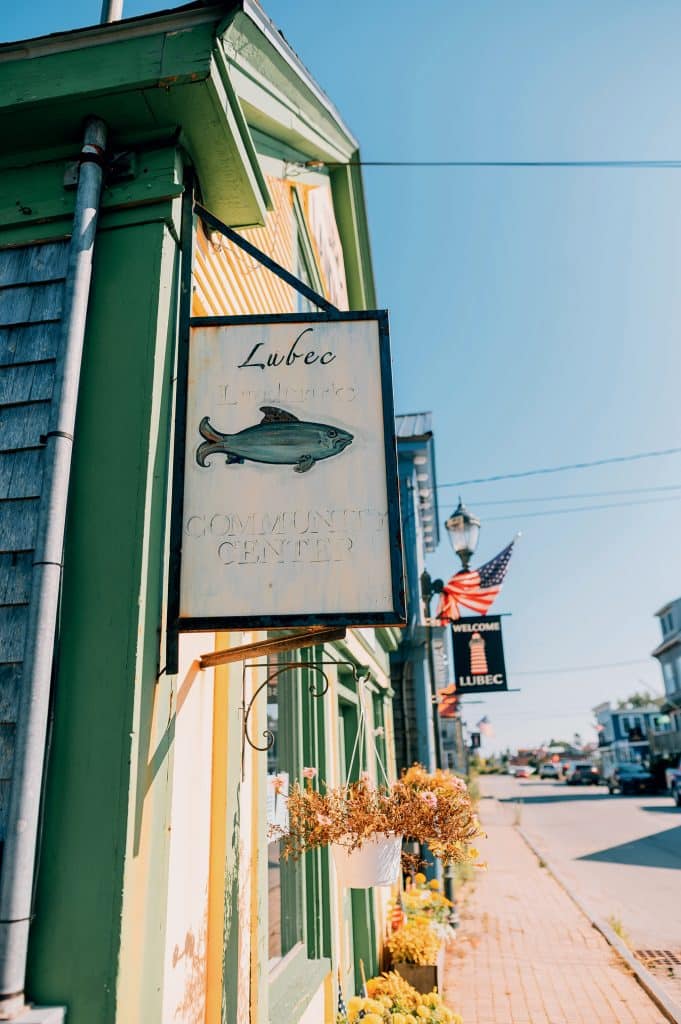
Photo Credit : Cait Bourgault
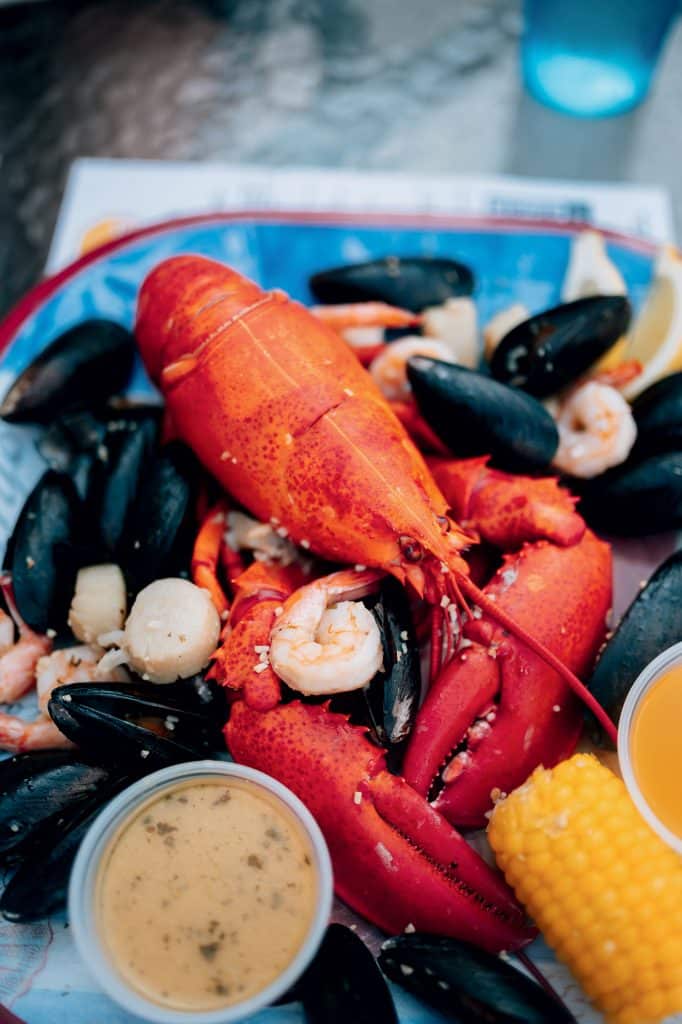
Photo Credit : Cait Bourgault
Eastport has seen more economic valleys than summits since then. Maine comedian Tim Sample once got laughs with his riff on Eastport’s ”Vacant Building Festival.” But new life has been flowing back into the uncommonly attractive brick downtown.
“I grew up here and came back 22 years ago,” says resident Hugh French. “I thought there was a chance to make a difference here.”
French founded the Tides Institute & Museum of Art, and started by acquiring an imposing 1887 brick building that once housed a bank and acts as an impressive bookend to one end of downtown. The institute has expanded to include a variety of programs, filling gaps in cultural offerings, ranging from artist residencies (it hosted 17 artists in 2022), to conserving and maintaining historic documents concerning the region, to fostering cross-border cultural cooperation with Canada. It’s also a preservation group: Since its founding, the institute has acquired nine local buildings, eight of which French says would have been demolished had they not intervened.
French says visitors tend to be surprised if not stunned that Washington County still exists in modern America—it’s almost wholly unblemished by strip malls or traffic, has plenty of open and forested space and lakes, and a stock of historic buildings. The most notable efforts hereabouts—from cultural protection to historic preservation to land conservation—invariably arise from smaller, grassroots efforts, as if a community barn-raising. “You add all those things up, and they do begin to amount to something,” French says. “And they help keep some of the character here.”
That’s evident in Columbia Falls, home to the proposed flagpole. It’s had one low-key attraction for decades: the home of prominent lumberman and jurist Thomas Ruggles, who had hired talented Massachusetts architect-builder Aaron Simmons Sherman to design and build a compact yet elegant house fitting for a person of his stature in 1818. It was deeded to the Ruggles House Society in 1950, and has welcomed a steady stream of visitors since.
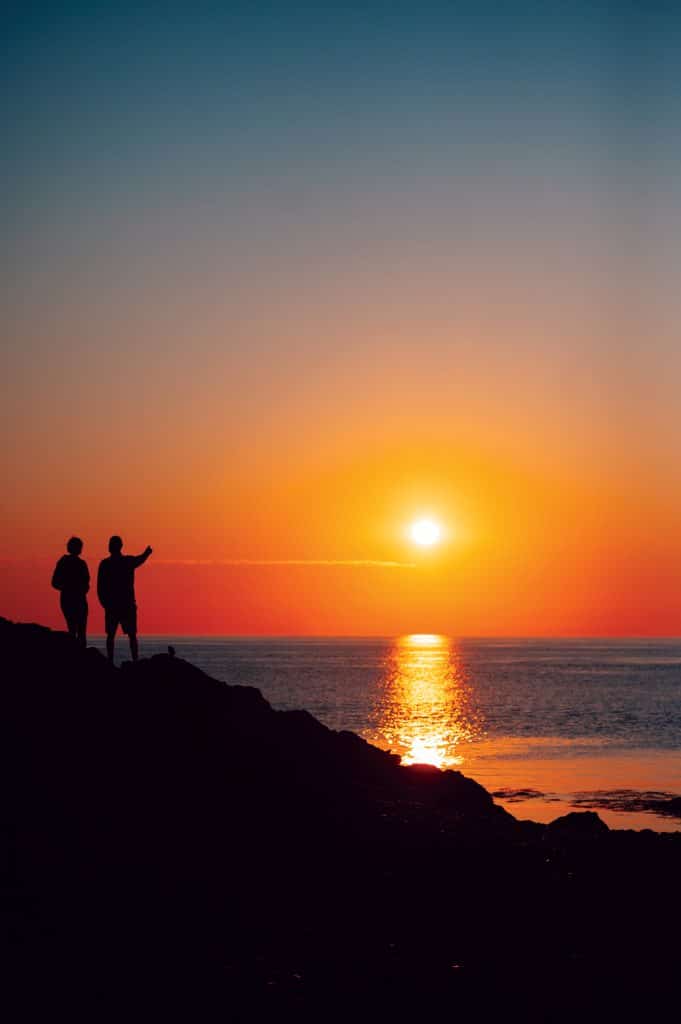
Photo Credit : Cait Bourgault
The house is a symmetrical bit of Federal dourness, at once grand and modest (it’s only one room deep). It is best known for its detailed interior woodwork, including mahogany paneling, delicate inlays, and a gravity-defying flying staircase. One story is that a British woodcarver spent three years on the mansion, largely using a humble penknife. The Metropolitan Museum of Art in New York apparently once had an eye to acquire it—one can picture it in an austere and muffled wing off Central Park, wowing urban gawkers—but local preservationists banded together in the late 1940s to keep it here and keep it open to the public.
Ultimately, this may be the most fitting emblem for the region: small-scale, locally cherished, largely unappreciated unless you pause to notice the details.
I stopped by for a visit to the house late last summer and knocked on the door. Nobody answered, despite the “Open” sign. It turned out a tour was under way, and I was left to idle outside for a spell until it finished. Across the street was the Worcester Wreath Company—the headquarters of the family behind the world’s largest flagpole project, the landmark that could reshape the county. I walked over and knocked, but nobody was around.
This seemed a fitting juxtaposition—tourism built around tiny, intricate carvings by a penknife, and tourism built around a mega-project that could change the region for generations.
The tides of history remain uniquely powerful in far Down East Maine. Yet it’s still unclear whether ebb or flow will prevail.
See More:
Guide to Beyond Acadia | Where to Eat, Stay, and Play in Coastal Northern Maine


